Much digital ink has been spilled about Pandora and its two rides. Let me be the first to reiterate what I said last week: Avatar–Flight of Passage is not only good, it’s transcendent. It was even better on my second flight than my first, and I would not be surprised if subsequent visits raised my opinion still higher. Such an amazing ride, which we will analyze in detail in a future editorial. But that said, today’s article is about the nighttime version of Pandora. Does it live up to expectations? Will people run home and tell others about it?
Short version: I think the nighttime version of Pandora actually disappoints on a few levels. I do NOT think people will run home and tell others they simply “must” visit Pandora in the near future.
A little stage-setting is in order. There are many folks who argue, somewhat convincingly, that Avatar lacks the thematic staying power of Harry Potter or Star Wars. Few people can name the characters of the movie, which itself was a thinly-camouflaged update of other eco-friendly movies. My retort until now was usually that everyone is forgetting what the crowds were saying when Avatar was in theaters: people were flocking back to the theater multiple times just so they could re-visit Pandora. They wanted to LIVE in that world, to wander in it, to explore its strangeness, and to revel in the unexpected light shows.
But they didn’t want the daytime Pandoran jungle. The floating mountains are nice and all, but what they really wanted was to walk around in the nighttime Pandora. The one in which every plant emits its own light. Where there is no need for a torch with fire because the foliage is every bit as bright as sunshine.
Translation: visitors to Walt Disney World’s version are going to want to re-live the movie, meaning they are going to want to experience the nighttime version of the land. In a way, the land has three attractions: the river journey, the banshee ride, and the nighttime lights and experience. We were excited to finally see the third one on the list, which had not really been shown to visitors during previews.
We visited on opening day (Saturday, May 27) and waited 45 minutes to get into the land (just after noon). Then we waited four hours for Flight of Passage, paused for an early dinner, then waited 3.5 hours for Na’Vi River Journey, expecting that the 8:17 sundown would mean that our 9:30 expected board time would translate into a fully altered land when we got out. We made it into the covered switchbacks just before sundown, so we weren’t tempted to watch the landscape transform in real time. We’d get out when it was already dark. The line was slower than expected–it was closer to 10:00 when we got on the ride–but at least the sky was very dark by then.
I was pleased with our timing. Surely we’d come off the ride and step into the very same landscape we’d just left behind in the ride, with ethereal blue light everywhere. We expected a glowing world, the kind you might imagine after having seen the Avatar movie. What we got was a bit short of that. There are definitely blacklights everywhere. Every so often, you saw an area off in the bushes highlighted by blacklights. But the glow was not “otherworldly.” Large portions of what your eye could see was dark, with only some areas highlighted. For want of a better phrase, I might suggest the whole thing looked like a college-level party, where someone had suggested a glow effect here and there.
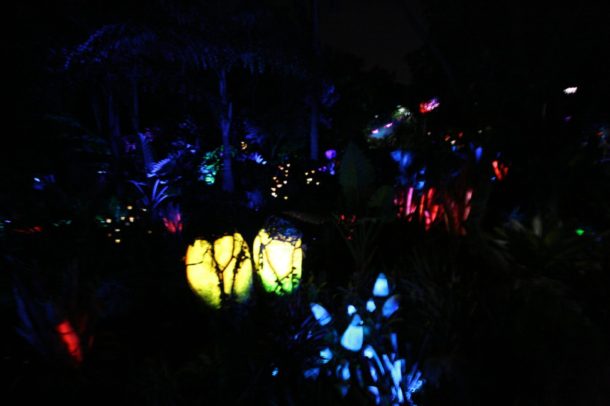
To be sure, there were some pathway effects not to be missed, right there on the ground. They were great. No one expects that the luminescent effects would react to your footsteps (like we saw in the movies)…that seems beyond our technology now. But what we saw was fun, and especially so if you were taking pictures. You’ve probably already seen a photo or two of these sparkling paths, and if you did, they likely excited your imagination.
These multi-colored paths caused us no end of excitement and fun. That was especially apparent for those of us who identified with photography, and the chance to capture something interesting. Let there be no doubt: if you feel this place is worth spending the time to get “just the right photograph,” then you will get it.
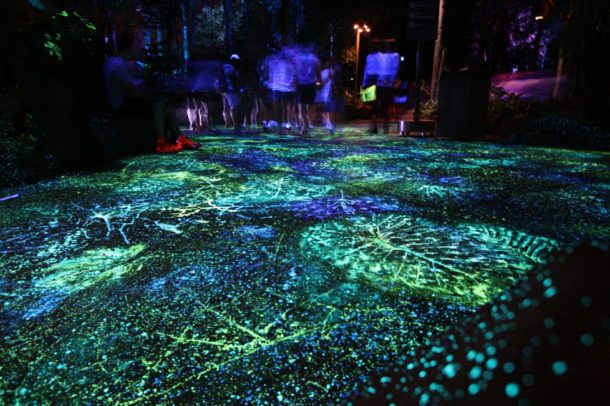 Using a Rebel XT on a 4-second exposure, with camera resting on a rock for stability.
Using a Rebel XT on a 4-second exposure, with camera resting on a rock for stability.
But let’s also not pretend these are more than they are: blacklight-lit features on a path that work great when there is a blacklight nearby…and less great when the light is further away.The result in person is an inconsistent pathway experience. Some areas are well-lit and look great, while others clearly have the light-reactive material embedded in them but are as dull as plain concrete because the only blacklights in the area are too far away.
Let’s also admit that this sort of thing photographs as “amazing” when you’ve got an SLR and a multi-second exposure…. but that’s not to say the “reality” looks like this. In a way, pictures are part of the problem, because they end up creating an expectation that cannot possibly be achieved when you are there in person.
Let me delve into an example. This is a photo from the DisneyParks blog showcasing the land:
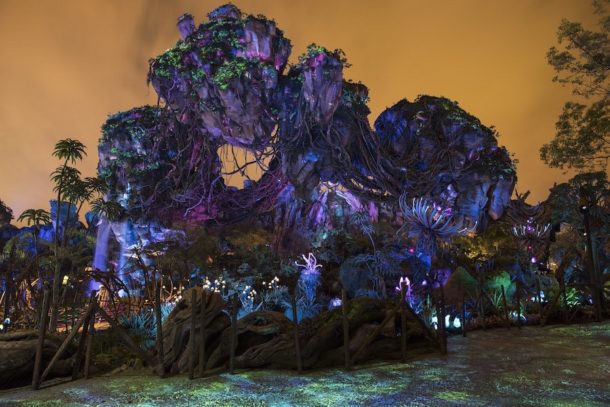
At first blush, this looks pretty darn amazing. Awfully close to your mind’s-eye vision of the nighttime trek across the jungle in the movie, in fact. But let’s analyze the photo for half a second. The sky should leap out to you as oddly colored. Why is there an orange sky? Is it only partly dark–just around sunset perhaps–and the land’s internal lights are bright enough to overcome all that? No chance. What you’re seeing is the captured glow of streetlights. For an SLR camera to capture streetlights in the background, hundreds of feet away, and turn the whole sky orange means that the exposure is VERY long. Keeping the camera lens open that long lets in a lot more light, and things that are dim in reality begin to look quite bright in the photos.
There’s the rub, because the reverse is also true. Things that look quite bright in photos look much more dim in person.
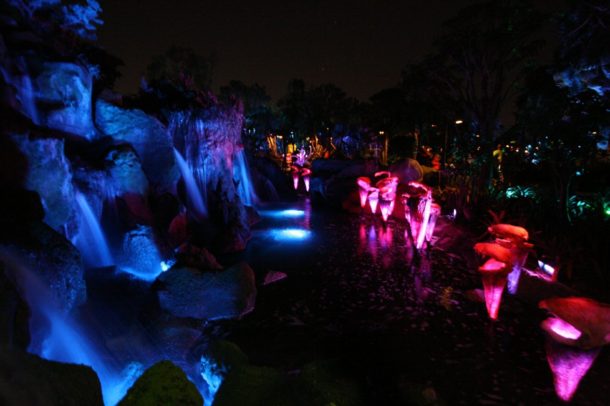
Look into the background for how lit (or unlit) the areas are.
Indeed, what we saw with our human eyes was pockets of lighting effects. A few spots here and there had low-level lights that might draw us over, but this was a VERY far cry from what we saw in the Avatar movies, and for that matter, pretty far from what we saw on the Na’Vi River Cruise. Keep in mind that we came off the cruise expecting to find a transformed world, and instead saw mostly darkness.
You could wander up to the odd bush with internal lighting and snap an interesting photo, but the experience feels a bit hollow. Also, there aren’t very many of them. I don’t want to go so far as to declare the nighttime Pandora experience a “bust”–it’s better than that, I feel. But at the same time, I think it’s important that we not pretend that the perfectly-staged photo accurately captured the land.
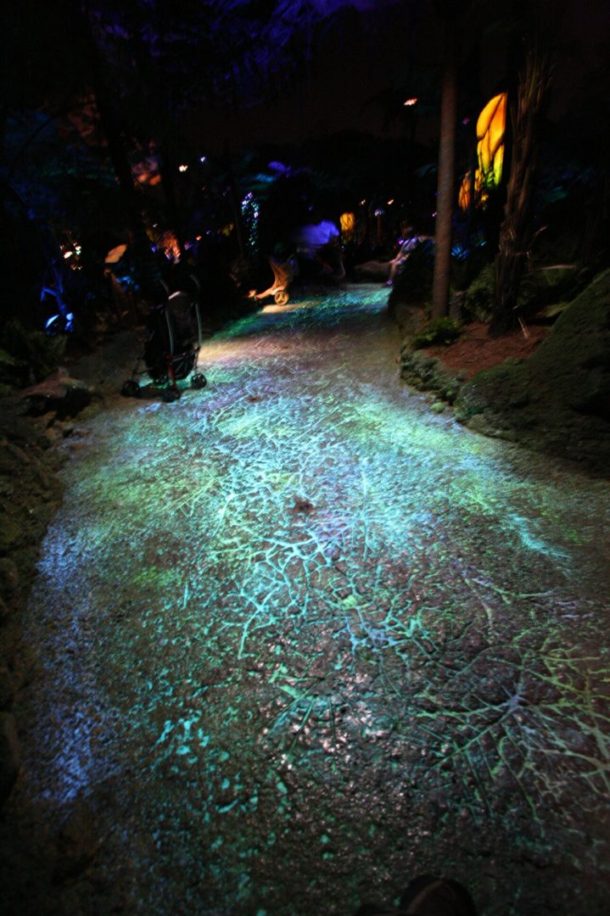
In a twist of irony, we came across some lighting effects on the way OUT of the land that would have worked better IN the land. Because nighttime EMH was massing in its own line to enter the land at the standard bridge, we had to walk out via the bridge to Africa (some grumbling ensued from our ten year old. Why not load in new EMH in this Africa path and let us walk out the regular bridge?)
But the newly-constructed path to Africa contained surprises. Have you seen those dispersal lasers that shoot an entire array of dozens of light points? These days, you sometimes see them as replacements for Christmas lights on the outside of houses. Those same laser machines look pretty awesome on the plants along this walkway. In fact, they looked better than the land we just left behind. We wondered why they didn’t just do that all over Pandora too…was it too much danger of a laser hitting someone’s eye?
Kudos on Crowd Control
I do want to pause for a moment and marvel at the operational prowess of the crowd control effort on Opening Day. I’ve been to many opening days at theme parks over the years, and some amount of chaos is expected. What I saw this weekend was, for the first time ever, what I would call managed chaos. Sure, there were hordes of people. Yes, there were moments when the flow of a pathway had to be halted to allow for the long banshee line to “cross over”, which required walls of humans to ensure that no one cut into the line and no actual chaos ensued.
Because the lines for the rides were long, they criss-crossed the land well outside the “normal” queue. That meant halting the line to leave room for people to do things like exit the restroom and cross the intersection.
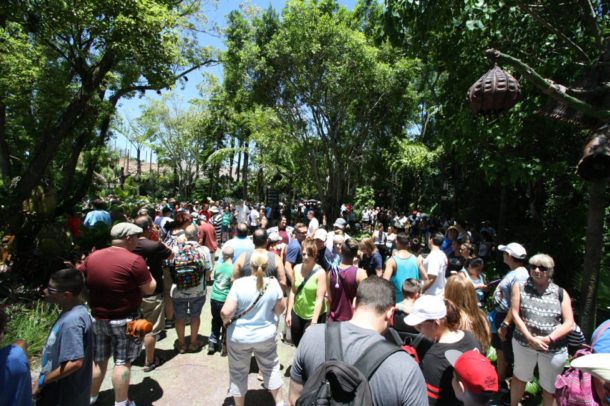 The photo doesn’t show it, but there IS an intersection here. It was organized.
The photo doesn’t show it, but there IS an intersection here. It was organized.
None of it felt “made up” in the moment. The entire affair had the practiced ease of a team that had not only thought through what could (in fact, *would!*) happen, but even had time to rehearse it. This is unheard-of in theme park openings, especially for an entire land. I think I’d go so far as to proclaim this was the single best-managed crowd-control operation I’ve ever seen in a theme park in my few decades of paying close attention, and that’s saying something.
There were even thoughtful water stations with free water in the wait to get into the land. Thank you! (Even if the labeled Zephyrhills bottles actually contained tap water).
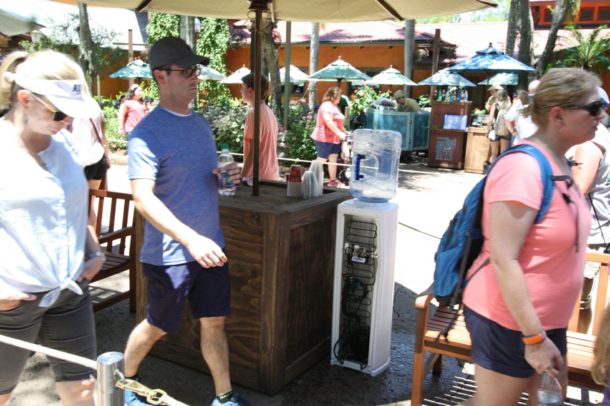
Put simply, it felt like a team of very smart people was put in charge of Guest Control decisions that first weekend. If I had a tiny quibble, it would be that the “line starts here” paddles (held by a human at the end of the line) for river journey were specifically-labeled, but the Flight of Passage paddles were generically labeled, so you had to ask verbally if that was the right line.
But I really wouldn’t want that to be the focus. I’d want the spotlight on the smart team that made decisions for this weekend, and give them some real applause. Also some heartfelt thank-yous to the front line folks in the steaming jungle (it was probably 95 degrees that day). I know you saw the propaganda at Disney University about “we work while others play” when you were first hired, but we in the general public don’t pause often enough to say thank you.
Bird on a Stick
Okay, so where’s the bird on a stick for THIS land?
In case the reference is obscure, let me explain. When Expedition Everest first opened, I knew immediately that the bird of prey you see at the very pinnacle, when your vehicle is stopped and about to go in reverse, was an endangered species. It was a neat mechanical effect, but hardly one central to the story, and even the bird’s piercing audible cry could stand on its own if the mechanical effect broke, so I knew right away this would be the first upkeep casualty of the new ride. Indeed, it was. For years it’s been on-again, off-again as a functioning device.
When I first rode the Na’Vi River Journey during annual passholder previews some ten days ago, I figured the metaphorical bird on a stick this time would be the jumping “frogs” overhead. At one point, there are giant floating “lily pads” over our heads, and they bounce slightly as projected small animals jump from pad to pad. It’s a really neat effect, but one that I put into the same category as the bird on a stick: the general public visiting for the first time won’t notice if the bounce/quiver effect isn’t working because they don’t expect it. It seemed like the sort of effect that would break first and not be fixed right away.
But I was wrong. The effect that died first turned out to be the floating air-jellyfish. If you know the movie, you recognize the reference. These little white jellyfish swim in the air, half the size of your palm, and glow incandescently. In the annual pass preview a week ago, we saw them all over the river journey ride, doing their jerky “swim” and then moving through the air. The results were impressive and immediately believable–it was one of the reasons it felt like “you were there” in Pandora.
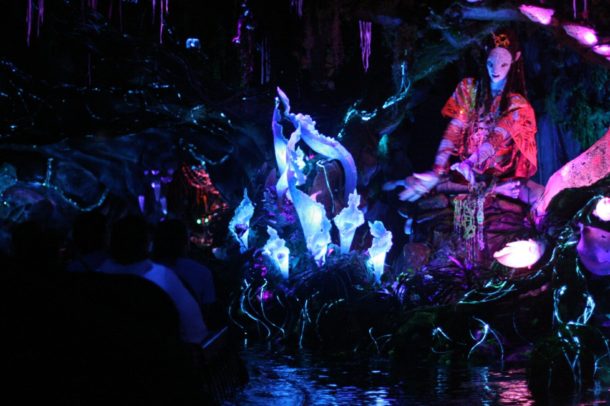 You can see a jellyfish on the left side of the photo.
You can see a jellyfish on the left side of the photo.
When we rode on opening day (mind you: OPENING DAY!) only about 40% of the floating jellyfish in the river journey were moving. The rest were immobile. Am I remembering this wrong? Were half of them immobile to begin with? If so, that’s a bad design choice, because either way, they look broken. It made me heartbroken to imagine the future. Would there be only one moving jellyfish in two weeks? Would the amazing audio-animatronic shaman be reduced to a single left-right motion as a puppet instead, in a variation of the Disco Yeti?
Opening Day should have had the best of the best, though I guess in today’s society that happens at the Media Day instead. The rest of us should go in fore-warned: the press photos do the land TOO MUCH justice, and the mechanical effects may be slightly less awesome than had been printed in the media.
Kevin Yee is the prolific author of many Disney books. You can find them listed on Amazon HERE.


You must be logged in to post a comment.